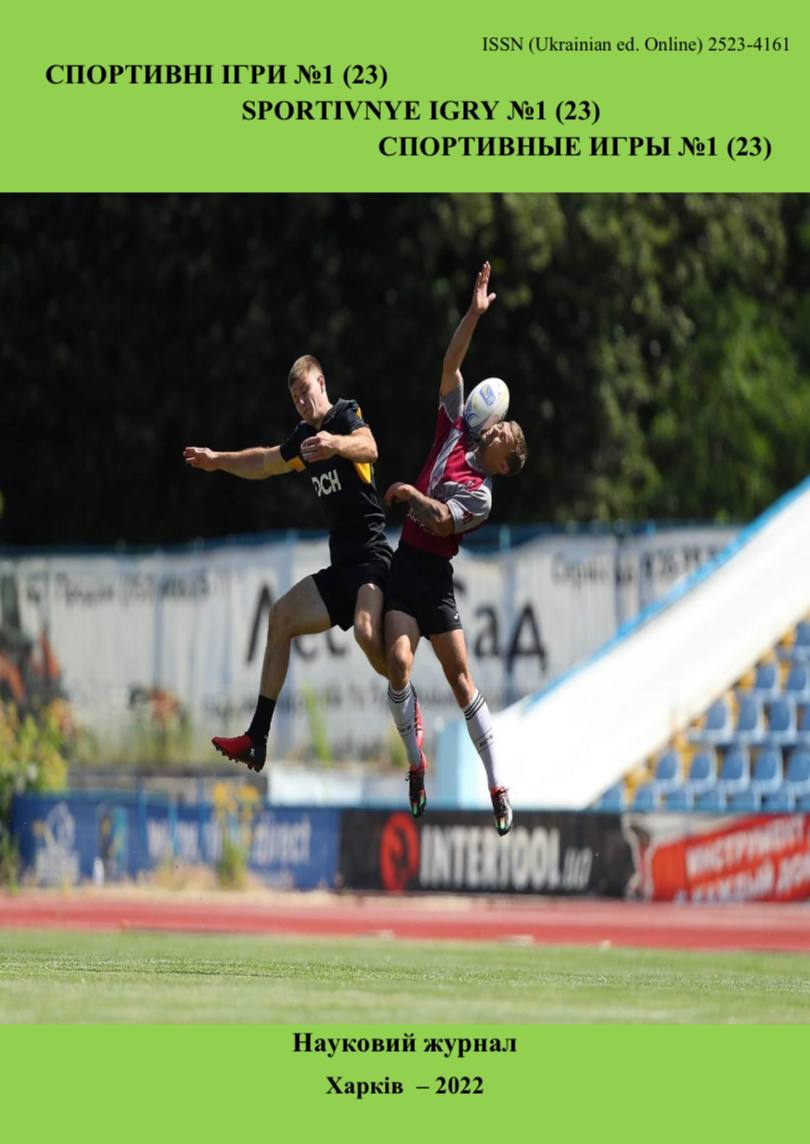Efficiency of the physical preparation program of badminton players aged 10-12 years by indicators of general physical preparedness
DOI:
https://doi.org/10.15391/si.2022-1.10Keywords:
efficiency, general physical preparation, badminton players, preparednessAbstract
Competitive activity in badminton at the present stage is qualitatively and significantly different
from the previous stage of development of this sport. An important aspect of improving the
preparedness of athletes is to determine the effectiveness of the physical preparation program
based on objective indicators of the heart rate of athletes within the competitive and training
activities. Purpose: to find out the impact of the physical preparation program on the level of
physical preparedness of badminton players aged 10-12 years at the stage of preliminary basic
training. Material and methods. There were used theoretical analysis and generalization of
scientific and methodological data, pedagogical observations of heart rate, pedagogical experiment
involving badminton players (26 boys of EG and 28 boys of CG), methods of mathematical
statistics. Results. The significant differences between the representatives of Ukrainian and Chinese
badminton schools (in terms of heart rate) in the framework of competitive activities and training
sessions that revealed in the previous stages of the study allowed to correct and change the
direction of physical preparation of badminton players aged 10-12 years. The influence of physical
loads within the author's physical preparation program was adjusted by several factors: the content
of exercises, average intensity of training exercises, duration and proportionality of athletes’
interposition in certain areas of heart rate, increasing the intensity and reduction of loads of
training exercises for badminton players. Conclusions. According to the obtained data, it can be
confirmed that the content of physical preparation programs used for EG and CG have almost the
same effect on the level of general physical preparedness of badminton players aged 10-12 years at
the stage of preliminary basic training. This can be seen in the case of such tests as long jump,
throwing a stuffed ball, crunches, push-ups and the accuracy of the reproduction of segments by
jumping. According to these tests, slightly higher efficiency was observed in the results of
badminton players aged 10–12 years of EG (by 0.33–4.92%, p>0.05) compared with CG. More
pronounced changes were found for pull-ups and seated forward fold with rectified knees, in the
representatives of the EG improvements were higher by 10.72% and 15.16% (p>0.05).
References
Abdullah, S. (2014). Effect of high intensity interval circuit training on the development of specific endurance to some of essential skills in youth badminton players. Journal of Advanced Social Research, no 4(3), 77-85.
Abián, P., Castanedo, A., Feng, X.Q., Sampedro, J. & Abian-Vicen, J. (2014). Notational comparison of men's singles badminton matches between Olympic Games in Beijing and London. International Journal of Performance Analysis in Sport, no 14, 42-53.
Bastug, G., Agilonu, A. & Balkan, N. (2017). A study of attention and imagery capacities in badminton players. Turkish Journal of Sport and Exercise, no 19(2), 307-312 doi: 10.15314/tsed.325694
Cabello-Manrique, D. & González-Badillo J.J. (2003). Analysis of the characteristics of competitive badminton. British Journal of Sports Medicine, no 37, 62-66.
Duncan, M.J., Chan, C.K., Clarke, N.D., Cox, M. & Smith M. (2017). The effect of badminton specific exercise on badminton short-serve performance in competition and practice climates. Eur J Sport Sci., no 17(2), 119-126. doi:10.1080/17461391.2016.1203362
Guven, F., Inceler, A., Aktas, S., Koc, S., Yilgin, A. & Er, Y. (2017). Effects of badminton training on some physical parameters in badminton players aged 10 to 12 years. Turkish Journal of Sport and Exercise, no 19(3), 345-349 doi: 10.15314/tsed.349484
Heang, L.J., Hoek, W.E., Quin, C.K. & Yin, L.H. (2012). Effect of plyometric training on the agility of students enrolled in required college badminton programme. Journal of Sports Sciences, no 24, 1-18.
Kah Loon Leong & Krasilshchikov, O. (2016). Match and Game Performance Structure Variables in Elite and Youth International Badminton Players. Journal of Physical Education and Sport, no 16(2), 330-334.
Karatnyk, I., Hrechaniuk, O., & Pityn, M. (2015). Structure and content of competitive activity of 15-17 years old badminton players. Journal of Physical Education and Sport, no 15(4), 834-837. doi:10.7752/jpes.2015.04128
Mahulkar, S. S. (2016). Relationship of strength and flexibility with skill performance in badminton players, International journal of Physical Education, Sports and Health, no 3(5), 38−40.
Ooi, C.H., Tan, A., Ahmad, A., Kwong, K.W., Sompong, R., Mohd Ghazali, K.A. & Thompson, M.W. (2009). Physiological characteristics of elite and sub-elite badminton players. Journal of Sports Sciences, no 27, 1591-1599.
Özgür, B. & Hotaman, F. (2020). Relationship between some motoric and technical performance characteristics of U17 Turkish national badminton players. Journal of Physical Education and Sport. no 20 (S. 3), 2205-2212.
Ozmen, T. & Aydogmus, M. (2017). Effect of plyometric training on jumping performance and agility in adolescent badminton players. Turkish Journal of Sport and Exercise, no 19(2), 222-227. doi: 10.15314/tsed.319749
Sturgess, S. & Newton, R.U. (2008). Design and implementation of a specific strength program for badminton. Strength Conditioning Journal, no 30, 33-41.
Tiwari, L. M., Rai, V., & Srinet, S. (2011). Relationship of selected motor fitness components with the performance of badminton player. Asian Journal of Physical Education Computer Science in Sports, no 5(1), 88-91.
Yadav, S. K. S. (2017). Relationship of selected motor fitness variables with the performance of badminton players, International Journal of Physical Education. Sports and Health, no 4(2), 145-147.













